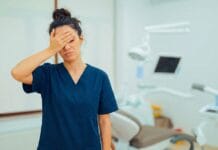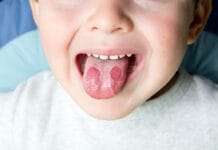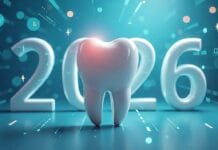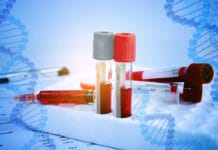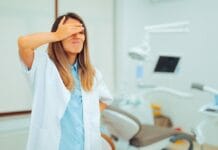ALARA is an acronym that stands for “as low as reasonably achievable.” It is the concept health care professionals use to reduce radiation exposure to patients and themselves. However, this concept is often misunderstood. This concept is meant to be used to determine risk versus benefit and not to guide health care professionals away from utilizing radiation to manage a disease or identify a problem.
Everything we are taught about radiation is taught from a fear-based perspective. This has caused issues with the public and, in some cases, has hindered our ability as health care workers to provide the treatment and care patients need and deserve.
Dental professionals are even prone to attacking each other on this topic because of the fear associated with radiation and its harmful effects. Some good news, though, is that we know more today than we did in 1975 when the U.S. Environmental Protection Agency (EPA) determined there was a linear no-threshold dose-response model that should apply to radiation exposure.1
With better science, technology, and understanding of the human body, the fear of overexposure and the harmful impact, lack of any health impact, or protective functions of radiation exposure are becoming more well-understood. Yes, I just said “protective function” when discussing radiation.
Low-Dose Radiation as Therapy
Even though it’s not widely accepted, there is a hypothesis that some level of radiation exposure is necessary for the immune system to work properly. Along with this theory, there is a more progressive theory that a certain level of radiation provides a protective function.
This is called radiation hormesis, and though it certainly is not something that should be adopted without clear evidence and safety guidelines, more clinical trials are being done on low-dose radiation therapy for treating some illnesses. Hundreds of clinical trials are currently using low-dose radiation as treatment for illnesses ranging from osteoarthritis, COVID-19, fungal infections, and, of course, a range of cancers.2
For clarification, “low-dose” radiation is defined by the International Commission on Radiological Protection as 100 mSv or less.5 This is a much lower dose than what has been historically used in radiation therapy for cancer, which uses high doses of radiation. For instance, primary tumors and gross lymphadenopathy in patients with head and neck cancer require 70 Gy for radiation therapy treatment (or 70,000 mSv), usually administered over several weeks with a daily dose of 2 Gy (2,000 mSv).3
Additionally, studies have shown a lack of radiation could be detrimental to living organisms which would support zero harm at levels below 100 mSv or the equivalent of background radiation. In one such study, bacteria were grown in an underground facility with no or very reduced levels of background radiation. The bacteria did not fare well without the low levels of radiation. It was discovered that the bacteria had an upregulation of oxidative stress and a reduction in growth rate which led the researchers to determine a stress response is triggered in the absence of normal levels of radiation.4,5
In another study using human lung fibroblast cells, a similar conclusion was made as upregulation of oxidated stress was observed in the cells that were placed in the facility with little to no radiation. Though this research clearly needs follow-up studies to further determine the effects on the human body in the absence of background radiation, these studies question the capability of radiation at background levels to stimulate defense mechanisms against stress.4,6
The current understanding of the damage, increased cancer risk, and/or heritable genetic damage associated with radiation exposure is extrapolated from high-dose radiation research. The linear no-threshold (LNT) model is a theory, a precautionary principle, in place with the trope of “better to be safe than sorry,” which is reasonable when considering the harmful effects associated with radiation exposure above 100 mSv. What is not known is if there are any risks to people who are exposed to radiation below 100 mSv (above background). Therefore, it is assumed that all radiation is dangerous.7
Most of the data used to determine radiation safety or lack thereof is based on atomic radiation and the health effects observed after the bombings in Hiroshima and Nagasaki.7
Before I go any further, let me be clear, in no way am I suggesting or encouraging anyone to disregard current guidance and regulation as it applies to the use of radiation.
What We Know about Low-dose Radiation
In recent years, there have been clinical trials and multiple studies to better understand the health effects of low doses of radiation on the human body. A confounding issue is that we are all exposed to background radiation, which can make it difficult to control. Even living in different cities changes the amount of background radiation one is exposed to throughout his or her life.
Radiation scientists want to evaluate the health effects of 100 mSv above the standard background radiation. This would apply to dentistry and medicine in the sense that we don’t generally expose the public/patients to more than 100 mSv above background radiation.8
In past reports, the United Nations Scientific Committee on the Effects of Atomic Radiation (UNSCEAR) stated that “radiation-inducible malignancies cannot be unequivocally attributed to radiation exposure because radiation is not the only possible cause and there are no generally available biomarkers that are specific to radiation exposure.”8
This concern about the fear instilled in the public and some health care providers are based on a lack of evidence rather than the evidence itself. In 2015, these concerns led to a petition to the Nuclear Regulatory Commission (NRC) by multiple scientists, including a health physicist, that requested changes in rulemaking regarding the use of the ALARA concept. The petitions requested the NRC amend “Standards for Protection Against Radiation” (10 CFR part 20). The petitions made four requests:9
- Maintain worker doses “at present levels, with allowance of up to 100 mSv (10 rem) effective dose per year if the doses are chronic.”
- Remove the As Low As Reasonably Achievable (ALARA) principle entirely from the regulations.
- Raise the public dose limits to be the same as the worker doses.
- “End differential doses to pregnant women, embryos and fetuses, and children under 18 years of age.”
This petition was denied because the petitions “fail to present adequate basis supporting the request to discontinue use of the LNT model.”9
Although these petitions were denied, multiple studies indicate the dose-response relationship is nonlinear. In one published article, the authors compared the contents of The Joint Report of the French National Academics of Science and Medicine and the Biologic Effects of Ionizing Radiation (BEIR) VII report of the American National Academy of Sciences (based in the U.S.). This was interesting as the two agencies came to different conclusions despite the similarities in the data reviewed.10
The authors of the French report believe that “epidemiological studies have been unable to detect in humans a significant increase of cancer incidence for doses about 100 mSv below.” This led to the conclusion that there is no significant data that demonstrates an increased risk of carcinogenesis for doses below 100 mSv in infants, children, and adults.10
Conversely, U.S. scientists argue there is a possibility that doses below 100 mSv can cause carcinogenesis. However, the BEIR VII report does not support this stance, stating “that no data demonstrate a carcinogenic effect on human beings below 100 mSv.”10,11 The French report advises that the LNT model can be used as a risk management tool but should not be used as a risk assessment tool.12
How to Apply ALARA
Why am I sharing this information? Because I want health care professionals, and especially dental hygienists, to understand that radiation needs to be respected but certainly should not be feared. There is no evidence to support the assertion that low doses of radiation, which we utilize in dentistry, harm our patients’ health.
This does not mean we go around shooting radiation at every person we see. What I’m suggesting is that we use guidelines and risk assessment tools to determine the lowest dose that is reasonable based on the patient’s particular situation.
For example, if you have a patient with high caries risk, the lowest reasonably achievable dose may be higher than someone with a low caries risk. The high caries risk patient may require radiographs every six months rather than every year, 18 months, or even up to two years.
Do you need a post-op radiograph after nonsurgical periodontal therapy to ensure you have removed all radiographic calculus? It is not unreasonable to take such a radiograph based on that patient’s needs. ALARA is not meant to be arbitrarily applied without some level of risk assessment in keeping the dose low and what benefits the patient.
Conclusion
What is reasonable for one patient may not be reasonable for another. Use radiation exposure with caution but be confident in the fact that there is a very, very low risk of causing harm to a patient through routine or even an extra dental radiograph from time to time.
It is estimated in the BEIR VII report that in a group of 100 people, 47 will develop cancer at some point in their life. Of that 47, one will be attributed to radiation exposure, and the other 46 will be due to other factors not related to radiation exposure.11
Use caution but understand that the benefit will outweigh the risk for most patients if you apply risk assessments for the patient’s needs. The only concern with taking radiographs in dentistry is when there is a lack of radiographs to provide the information needed to assess the patient’s oral health.
Before you leave, check out the Today’s RDH self-study CE courses. All courses are peer-reviewed and non-sponsored to focus solely on pure education. Click here now.
Listen to the Today’s RDH Dental Hygiene Podcast Below:
References
1.Calabrese, E. J. (2019). EPA adopts LNT: New historical perspectives. Chemico-Biological Interactions, 308, 110–112. https://doi.org/10.1016/j.cbi.2019.05.027
- Clinical Trials: Low-Dose Radiation Clinical Trials. (2023). U.S. National Library of Medicine. https://clinicaltrials.gov/ct2/results?cond=&term=low+dose+radiation&cntry=&state=&city=&dist=
- Yeh, S.A. Radiotherapy for head and neck cancer.Seminars in Plastic Surgery. 2010;24(2): 127-136. https://doi.org/10.1055/s-0030-1255330
- Belli, M., Indovina, L. The Response of Living Organisms to Low Radiation Environment and Its Implications in Radiation Protection. Frontiers in Public Health. 2020; 8. https://doi.org/10.3389/fpubh.2020.601711
- Castillo, H., Smith, G.B.Below-background Ionizing Radiation as an Environmental Cue for Bacteria.Front Microbiol. 2017; 8. https://www.frontiersin.org/articles/10.3389/fmicb.2017.00177/full
- Carbone, M.C., Pinto, M., Antonelli, F., et al. Effects of Deprivation of Background Environmental Radiation on Cultured Human Cells. Il Nuovo Cimento. 2010; 125(4):469-477. https://www.researchgate.net/publication/231178708_Effects_of_deprivation_of_background_environmental_radiation_on_cultured_human_cells
- Radiation Risk in Perspective: Position Statement of The Health Physics Society. (2019, February). Health Physics Society. https://hps.org/documents/radiationrisk.pdf
- Uncertainty in Risk Assessment: Position Statement of the Health Physics Society. (2013, February). Health Physics Society. https://hps.org/documents/riskassessment_ps008-2.pdf
- Nuclear Regulatory Commission. (2021, August 17). Linear No-Threshold Model and Standards for Protection Against Radiation. Federal Register: The Daily Journal of the United States Government. https://www.federalregister.gov/documents/2021/08/17/2021-17475/linear-no-threshold-model-and-standards-for-protection-against-radiation
- Tubiana, M., Aurengo, A., Averbeck, D., Masse, R. Recent Reports on the Effect of Low Doses of Ionizing Radiation and Its Dose-effect Relationship.Radiation and Environmental Biophysics. 2006;44(4): 245-251. https://doi.org/10.1007/s00411-006-0032-9 9. https://pubmed.ncbi.nlm.nih.gov/16468064/
- National Academies of Sciences, Engineering, and Medicine. (2006). Health Risks from Exposure to Low Levels of Ionizing Radiation: BEIR VII Phase 2. The National Academies Press. https://nap.nationalacademies.org/read/11340/chapter/1#xvi
- Ryan, M.T. (2007, January 11). Report of The French Academy of Sciences, “The Dose-effect Relationship and Estimating the Carcinogenic Effects of Low Doses of Ionizing Radiation” [ACNWR-0258]. United States Nuclear Regulatory Commission Advisory Committee on Nuclear Waste. https://www.nrc.gov/docs/ML0701/ML070160572.pdf


